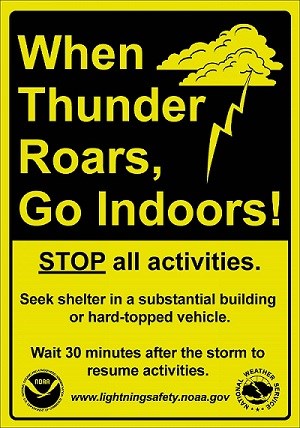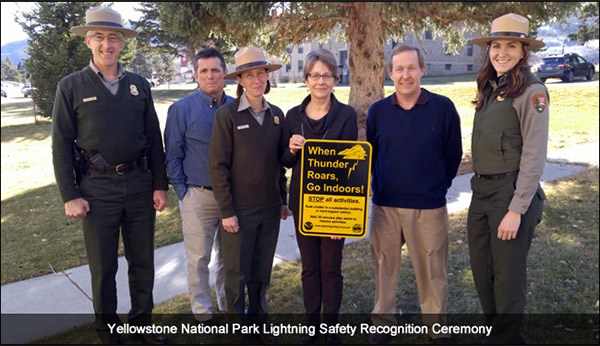Last updated: June 25, 2018
Article
When Thunder Roars, Go Indoors

NOAA
Lightning is a spark of electricity in the atmosphere between clouds, the air or the ground. We usually associate lightning with thunderstorms. The booming sound of thunder is actually a result of lightning. To learn more about what causes lightning and how it works, check out NOAA’s National Severe Storms Laboratory.
Lightning is common in the summer months; however, it can strike any time of the year. The best way to protect yourself from a lightning strike is to avoid the threat. If you hear thunder, you are close enough to be struck by lightning. REMEMBER: There is NO PLACE outside that is safe during a thunderstorm!
-
Check the weather forecast before you travel to the park. If the weather forecast predicts thunderstorms in the area, have a Plan B ready.
-
Plan your activities around the weather. In summer months, thunderstorms usually develop in the early afternoon, although they can occur at any time. Leave for your trip in the early morning to avoid running into storms.
-
Find out more about the threat of lightning in your park. Check the park’s website or ask a ranger if there are certain locations that are at high risk for lightning strikes.
-
Know where to go in the event of lightning. Ask a ranger if there are designated safe locations for visitors within the park. Check the park website and visitor center for lightning safety guidance. Some parks have lightning detection and notification systems that can alert you when lightning is in the area.
-
Know how long it will take for you to get to safe shelter. Plan ahead and be aware of how far you are away from safety if you are outside and encounter lightning or thunder.
-
Listen to the NOAA Weather Radio. NOAA provides the latest weather conditions and forecasts even for remote areas that may not have cellular coverage. You can also sign up for text and email weather reports and updates, such as NWS Wireless Emergency Alerts. Just remember, not all parks have cell service, so check in with park rangers for alerts before you go on your adventure.
- Look out for dark skies and listen for thunder. If you can hear thunder, you are at risk of being struck by lightning.
-
Do not wait. If you are outside, move towards shelter immediately.
-
Seek shelter in enclosed buildings. Rain shelters, small sheds, pavilions/picnic shelters, porches and open vehicles are NOT safe (NWS). Tents do not protect you from lightning. Make sure you know where it is safe to go in the park if there is lightning.
-
Enclosed vehicles with hard tops can be used to shelter if you are unable to make it to a building. Make sure the windows are rolled up and avoid contact with metal surfaces outside or inside the vehicle.
-
Wait at least 30 minutes after seeing lightning or hearing thunder before resuming your activity. You are still at risk of being struck by lightning after a storm has passed. Don’t go back outside just because the rain has slowed or stopped.
- Keep moving towards safe shelter. If you are caught out in the open, do not stop.
-
Stay away from isolated trees or other tall objects. You do not want to be the tallest object! If you are in a forest, stay within a lower group of trees.
-
Avoid open fields, hills, boulder fields, rocky outcrops, and ridge tops. Do not lie flat on the ground.
-
Avoid bodies of water and metal objects, which can conduct electricity.
- Distance yourself from others in your group. Spread out so that at most only one person is likely to be hurt by lightning and the others can apply first aid.
-
Call 9-1-1 immediately. It is safe to use a cell phone during a storm. Give specific directions to your location. Provide as many details of your location to help emergency services access you and the victim.
-
If necessary, move the victim to a safer place. There may still be a threat of lightning when you are responding to a victim. Asses the situation and determine if the victim can be moved to a safer location to avoid the possibility of a second lightning strike.
-
Provide basic first aid and supportive care until help arrives. A lightning strike can stop the heart. If a person is unconscious and not breathing, start CPR and if you can, find and apply an Automated External Defibrillator (AED). Lightning can also cause burns, shock and blunt trauma. Do not move anyone who is bleeding or appears to have broken any bones (CDC).
- Learn more about how lightning strikes people and how to respond to a lightning strike victim.

NPS Photo
